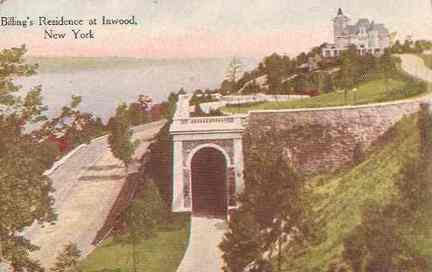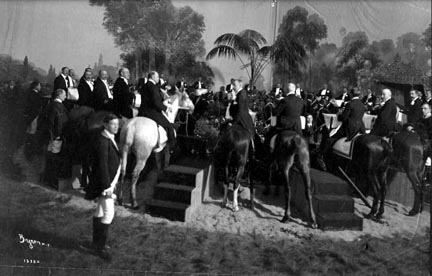
One of Fort Tryon Parks most illustrious residents was Cornelius Kingsley Garrison Billings. He was a wealthy industrialist, a noted horseman and a tycoon from Chicago who wanted to take part in New York City's social and financial circles.
In 1901 Billings retired at the age of 40 as the President of the Peoples Gas, Light and Coke Company in Chicago. The company was family owned. He had the customary pursuits of a millionaire which included such pastimes as yachting, race horses and carriage driving. He frequently joined others at the Harlem River Speedway in racing which was one of the reasons for his purchase of property in the area.
Even though the Billings residence was on Fifth Avenue and 53rd Street he wanted to have a summer estate in northern Manhattan. Billings purchased 25 acres from the estates of A. T. Stewart, William Libbey, Augustus Johnson, William C. Muschenheim, and William Tweed. Billings proceeded to build the mansion which was to be called Tryon Hall and it was to become one of the most impressive mansions in the community.

This Louis XIV-style mansion was built on the highest point of the property, 250 feet above the Hudson River on the site of Fort Tryon used by both Americans and British during the American Revolution. Guy Lowell designed the building and the landscaping was done by Charles Downing Lay. The property had private plumbing with three standpipe outlets on each floor of the house. The site of the house was located on the terraces at the north end of what is now the Heather Gardens.
The driveway was designed by Buchman & Kahn in the form of an S-curve. The length was 1,600 feet rising 100 feet on a 6 degree grade. The entrance was at the Henry Hudson Parkway. The drive went under a galleried entranceway which is 50 feet high and is made of Maine Granite. The lower roadway was cut into rock and as it turned up hill the archway was the main support for the rest of the road. This part of the property was constructed at a cost of $250,000 and by today's standards would be worth $4 million. The drive was made of fire baked bricks.
There had also been a swimming pool, pergola, formal gardens. It had been said that Billings spent $2 million on the estate which was completed in 1907. He also had a yacht landing on the Hudson River next to the Dyckman Street Ferry landing.
On and near the property Billings constructed stables for his horses and had a sizable garage for the automobiles he owned. He had a private passion for these two subjects. In 1903, Billings gave a dinner to celebrate the opening of the stables. Guy Lowell, architect for Tryon Hall, was commissioned to design and construct the 25,000 square foot building. It contained 22 carriages, 33 horses, a harness room, carriage wash and a change room for men. It had battered stucco walls and a flaring shingled roof and cost $200,000 to build.
According to the New York Tribune a party to celebrate the construction of the stable and carriage house was scheduled to be at his estate. Due to the crowds at the entrance the party was relocated to Sherry's Restaurant on Fifth Avenue and 44th Street. The floor was covered with a form of imitation grass and the waiters were dressed as hunting grooms.
The 36 guests were served food and drink while mounted on horses specifically
rented for the occasion. They were facing each other in a circle
as if in some form of riding drill. Each horse had a specially fitted
dining tray for the saddle and champagne was in a saddle bad fitted with
tubes for rider consumption. Even the horses were allowed to have
dinner too, oats.

Over the past few decades it was thought by local residents that the carriage house was near the restaurant in Fort Tryon Park. In reality the structure was was actually located on the Harlem River Speedway and 197th Street.
The photo below was taken from the Manhattan side of the Harlem River looking north towards the Washington Bridge
(not GW) which connects from 181st Street in Manhattan to the Bronx. The dirt road on the
left would be the present-day Harlem River Drive. In 1902 this was known as the Harlem River Speedway
which was built for the well-heeled to race their horses and carriages. The Speedway was
the primary reason that Billings chose to build his estate where Fort Tyron Park is today.

This confirmation was found in the book, NEW YORK 1900, by Robert A. M. Stern, Gregory Gilmartin, and John Messengale. According to the book the stables were placed at the speedway for convenience as the racing and trotting of horses were done there. In time the building was converted to an automotive garage to accommodate his fancy for auto racing.
According to the 1910 Census, Billings listed himself, his wife, 2 children and 23 servants as part of the household and staff. He had listed his occupation as capitalist.
Billings was instrumental in the placing of a bronze plaque secured on the eastern face of rocks where Fort Tryon once stood. This plaque was made at the recommendation of William Muschenheim, a former landowner and trustee for the American Scenic and Historic Preservation Society, who was interested in the history of Fort Tryon. Billings was also a member of the society and commissioned Charles R. Lamb to design it.
The plaque reads as follows:
1776 - 1909, HUDSON-FULTON CELEBRATION COMMISSION, ON THIS HILLTOP STOOD FORT TRYON, THE NORTHERN OUTWORK OF FORT WASHINGTON, ITS GALLANT DEFENSE AGAINST THE HESSIAN TROOPS BY THE MARYLAND AND VIRGINIA REGIMENT, 16 NOVEMBER 1776, WAS SHARED BY MARGARET CORBIN, THE FIRST AMERICAN WOMAN TO TAKE A SOLDIERS PART IN THE WAR FOR LIBERTY, ERECTED UNDER THE AUSPICES OF THE AMERICAN SCENIC AND HISTORIC PRESERVATION SOCIETY THROUGH THE GENEROSITY OF C. K. G. BILLINGS.
In 1917 Billings sold Tryon Hall and the surrounding land to John D. Rockefeller for $35,000 per acre. Billings bought land in Oyster Bay and an apartment at 820 Fifth Avenue near 63rd Street... In 1925 Tryon Hall was unfortunately destroyed by a fire. According to the New York Times the fire lasted well into the night. It was watched by many residents and also by people who were visiting the community.
The Billings estate and mansion had been immortalized in the Philo Vance mystery. THE DRAGON MURDER CASE, by S. S. Van Dine. Even though the mystery took place in Inwood Hill Park the author had taken liberty with the description of the Billings mansion in the book to be used for the fictional Stamm mansion.
The remains of this grand estate can still be seen today. These are the stone gates and gate house, the brick carriage road with archway, which is now a scenic overlook, connecting the property with the Henry Hudson Parkway. During the construction of Fort Tryon Park and the Cloisters the brick roadway of the Billings estate was paved over to protect the bricks from the trucks coming into the park from the Henry Hudson Parkway. The paving was recently removed and is now now part of the pedestrian pathway of the park.
The former property, now incorporated into Fort Tryon Park, has become one of the most scenic wonders of the City and the Hudson Valley. It is hoped that many will continue to appreciate what Billings and Rockefeller had seen and will last throughout the Twenty-first Century,
Mass transit connects Fort Tryon Park with the rest of New York City. The M4 bus originates in midtown and goes into the park and stops at the cloisters. The A train stops at the 190th Street and Fort Washington Avenue near the Margaret Corbin Circle and travels downtown to lower Manhattan and Brooklyn.
For more information on Fort Tryon Park, the Metropolitan Museum of Arts-Cloisters,
and transit information you can access the following web sites on the Internet:
The Metropolitan Museum of Arts website can be accessed at
www.metmuseum.org
Fort Tryon Park is mentioned on the website for the New York City Department
of Parks and Recreation at
www.nyc.gov/parks.
For information on the C.K.G. Billings Amateur Driving Championships, you
can visit the website of the United States Trotting Association at
www.ustrotting.com/misc/billings/docs